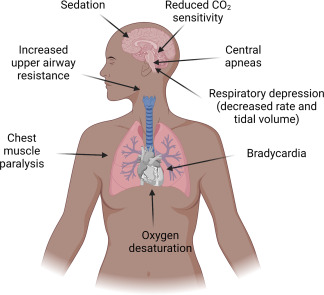A woman with severe preeclampsia is receiving a magnesium sulfate infusion. The nurse becomes concerned after assessment when the woman exhibits:
a sleepy, sedated affect.
absent ankle clonus.
a respiratory rate of 10 breaths/min.
deep tendon reflexes of 2+.
The Correct Answer is C
Choice A reason: A sleepy, sedated affect is not a concerning sign, as it is a common side effect of magnesium sulfate. Magnesium sulfate is a central nervous system depressant that can cause drowsiness, lethargy, and reduced alertness.
Choice B reason: Absent ankle clonus is not a concerning sign, as it indicates a normal neuromuscular response. Ankle clonus is a rhythmic jerking of the foot when the ankle is dorsiflexed. It is a sign of hyperreflexia, which can occur in severe preeclampsia due to increased blood pressure and cerebral edema.
Choice C reason: A respiratory rate of 10 breaths/min is a concerning sign, as it indicates respiratory depression. This is a serious complication of magnesium sulfate toxicity, which can lead to respiratory arrest and death. The nurse should monitor the woman's respiratory rate closely and report any signs of respiratory distress.
Choice D reason: Deep tendon reflexes of 2+ are not a concerning sign, as they indicate a normal neuromuscular response. Deep tendon reflexes are graded from 0 to 4, with 2 being the average. Magnesium sulfate can cause hyporeflexia or areflexia, which are signs of magnesium sulfate toxicity.

Nursing Test Bank
Naxlex Comprehensive Predictor Exams
Related Questions
Correct Answer is ["A","B","E","F"]
Explanation
Choice A reason: Limiting time spent wearing a wet bathing suit is a good preventive measure, as it can reduce the moisture and warmth that can promote the growth of bacteria and fungi in the genital area. The nurse should advise the 15-year old to change into dry clothes as soon as possible after swimming or bathing.
Choice B reason: Not douching is a good preventive measure, as it can preserve the natural balance of the vaginal flora and pH. The nurse should explain to the 15-year old that douching can wash away the protective mucus and lactobacilli that prevent infections, and it can also introduce harmful substances or microorganisms into the vagina.
Choice C reason: Wearing nylon undergarments is not a good preventive measure, as it can trap heat and moisture in the genital area and create a favorable environment for infections. The nurse should recommend the 15-year old to wear cotton or breathable fabrics that can absorb sweat and allow air circulation.
Choice D reason: Using floral scented bath salts is not a good preventive measure, as it can irritate the genital mucosa and alter the vaginal pH. The nurse should caution the 15-year old to avoid using any products that contain perfumes, dyes, or chemicals in the genital area, as they can cause allergic reactions or infections.
Choice E reason: Decreasing sugar intake is a good preventive measure, as it can lower the risk of yeast infections. The nurse should educate the 15-year old that sugar can feed the growth of Candida albicans, which is a common cause of vaginal candidiasis. The nurse should also encourage the 15-year old to eat a balanced diet that includes probiotics, such as yogurt, to maintain a healthy vaginal flora.
Choice F reason: Avoiding tight-fitting jeans is a good preventive measure, as it can prevent friction and pressure on the genital area. The nurse should suggest the 15-year old to wear loose or comfortable clothing that can reduce the risk of skin irritation or injury, which can lead to infections.
Correct Answer is A
Explanation
Choice A reason: The NST has no known contraindications, as it is a non-invasive and safe test that does not stimulate uterine contractions or cause fetal distress. It is the most widely used method of antepartum fetal surveillance.
Choice B reason: The NST is not slightly more expensive than the CST, as it requires less time and equipment. The NST usually takes 20 to 40 minutes, while the CST may take up to 2 hours. The NST only needs a fetal monitor, while the CST also needs an intravenous line and oxytocin infusion.
Choice C reason: The NST does not have fewer false-positive results than the CST, as it has a higher rate of nonreactive results that may indicate fetal compromise when there is none. A nonreactive NST is one that does not show at least two accelerations of the fetal heart rate of 15 beats per minute or more lasting 15 seconds or more in a 20-minute period.
Choice D reason: The NST is not more sensitive in detecting fetal compromise than the CST, as it has a lower predictive value for fetal well-being. A reactive NST is one that shows at least two accelerations of the fetal heart rate of 15 beats per minute or more lasting 15 seconds or more in a 20-minute period. However, a reactive NST does not rule out the possibility of fetal hypoxia or acidosis.
Whether you are a student looking to ace your exams or a practicing nurse seeking to enhance your expertise , our nursing education contents will empower you with the confidence and competence to make a difference in the lives of patients and become a respected leader in the healthcare field.
Visit Naxlex, invest in your future and unlock endless possibilities with our unparalleled nursing education contents today
Report Wrong Answer on the Current Question
Do you disagree with the answer? If yes, what is your expected answer? Explain.
Kindly be descriptive with the issue you are facing.
